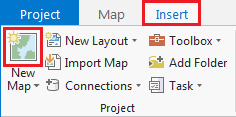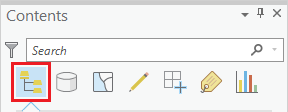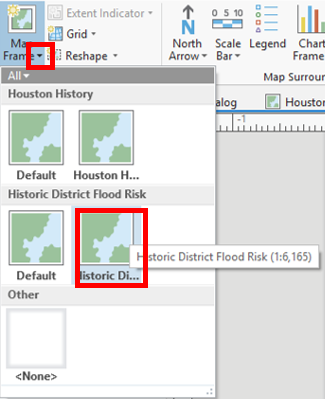TABLE OF CONTENTS
| Table of Contents |
|---|
| Info |
|---|
This guide was created by the staff of the GIS/Data Center at Rice University and is to be used for individual educational purposes only. The steps outlined in this guide require access to ArcGIS Pro software and data that is available both online and at Fondren Library. The following text styles are used throughout the guide: Explanatory text appears in a regular font.
Folder and file names are in italics. Names of Programs, Windows, Panes, Views, or Buttons are Capitalized. 'Names of windows or entry fields are in single quotation marks.' "Text to be typed appears in double quotation marks." The following step-by-step instructions and screenshots are based on the Windows 10 operating system with the Windows Classic desktop theme and ArcGIS Pro 2.1.3 software. If your personal system configuration varies, you may experience minor differences from the instructions and screenshots. |
Obtaining the Tutorial Data
There are two ways of obtaining the tutorial data. Option 1 is best if you are completing this tutorial in one of our short courses or from Fondren Library and Option 2 is best if you are completing the tutorial from your own computer.
...
If you are completing this tutorial from a public computer in Fondren Library and are logged on using the gistrain profile, follow the instructions below:
- On the Desktop, click the File Explorer icon located on the Windows Taskbar at the bottom left corner of the screen.
- In the 'File Explorer' window, click This PC on left side panel and then navigate to double-click the Computer icon > gisdata (\\file-rnas.rice.edu) (R:) > Short_Courses > HIST207 > HIST207_GDC1
- To create a personal copy of the tutorial data, drag the Intro_Part1 folder onto the Desktop.
- Close all windows.
OPTION 2: Accessing tutorial data online using a personal computer
...
| Info | ||||
|---|---|---|---|---|
| ||||
- Click Intro_Part1.zip above to download the tutorial data.
- Open the Downloads folder.
- Right-click Intro_Part1.zip and select Extract All....
- In the 'Extract Compressed (Zipped) Folders' window, accept the default location into the Downloads folder.
- Uncheck Show extracted files when complete.
- Click Extract.
- Directly within the Downloads folder, drag the Intro_Part1 folder onto your Desktop.
...
| Info |
|---|
The following step-by-step instructions and screenshots are based on the Windows 7 10 operating system with the Windows Classic desktop theme and ArcGIS Pro 2.1.3 software. If your personal system configuration varies, you may experience minor differences from the instructions and screenshots. |
...
- On the Desktop, double-click your Intro_Part1 folder to open it.
- Double-click the Intro_Part1 .aprx file ArcGIS Project File (blue icon) to open the existing project in ArcGIS Pro.
- Maximize the ArcGIS Pro application window.
Creating a New Map
A map is a project item used to display and work with geographic data in two dimensions. The first step to visualizing any data is creating a new map.
The ribbon runs horizontally across the top of the ArcGIS Pro interface. Tools (buttons) are organized into tabs along the ribbon.
- On the ribbon, click the Insert tab.
- In the Project group, click the New Map button.
You will notice that a new map Map view opens in the main section of ArcGIS Pro.
The panel on the left side of ArcGIS Pro is called the Contents pane. After creating a new map, the Contents pane now displays the default Map Map title and automatically adds the Topographic basemap layer to the map.
...
- Right-click the COH_HISTORIC_DISTRICTS feature class and select Add To Current Map.
- An alternative method of adding data to a map is to click and hold the Major_Rivers feature class and drag and drop it into the Houston History map view Map view.
- Repeat either of the above two options methods to add COH_HISTORIC_SITESLANDMARKS to the Houston History map Map view.
- Above the ribbon, on the Quick Access toolbar, click the Save button.
...
It is early in the project to be deciding upon symbology, however, when layers are added to a map, ArcGIS Pro assigns then layers a random color symbol. Sometimes the colors are very faint and difficult to see on top of the basemap or the colors of multiple layers are very similar to each other and difficult to distinguish. To ensure that everyone can easily see the layers we are working with, we will adjust the basic symbology.
- In the Contents pane, right-click the Major_Rivers layer name and select Symbology to open the Symbology pane on the right.
Notice that the 'Primary symbology' defaults to Single Symbol. With this type of symbology, all features in that particular layer will be assigned the same symbol.
- For 'Symbol', click the colored line symbol to switch to Format Line Symbol mode.
- Within Format Line Symbol mode, click the Properties tab.
- For 'Color', use the drop-down menu to select Cretan Blue. The rivers on the map should now all be blue and easily visible.
- At the bottom of the At the bottom of the Symbology pane, click Apply.
The rivers on the map should now all be blue and easily visible. The 'Format Symbol' mode of the Symbology tab can also be accessed directly via the small layer symbol (instead of beneath the layer name ) in the Contents pane.
- In the Contents pane on the left, click the colored rectangle symbol beneath the COH_HISTORIC_DISTRICTS layer name.
- For 'Color', use the drop-down menu to select Mango.
- For 'Outline color', use the drop-down menu to select Gray 50%.
- At the bottom of the Symbology pane, click Apply.
...
- Repeat either of the above two methods to change the symbology of COH_HISTORIC_SITESLANDMARKS to: 'Color' = Burnt Umber and 'Size' = 5 pt.
- Your three layers should now look like the below image.
- Above the ribbon, on the Quick Access toolbar, click the Save button.
Navigating the Project
Navigating the Contents Pane
At the top of the Contents pane, there is a series of seven buttons. By default, the leftmost button is selected: 'List by Drawing Order'.
When this button is selected, the order in which the layers are listed corresponds to the order in which the layers are visually stacked in the Map view. To test how the drawing order works, you will reorder the layers.
...
- Uncheck the Major_Rivers layer to turn off its visibility in the map Map view.
- Check the Major_Rivers layer to turn its visibility back on in the map Map view.
Navigating the Map
...
view
You will now learn how to navigate the Map view by panning, zooming, and using spatial bookmarks.
...
To pan the map:
- Within the map Map view, click and hold the left mouse button and drag the mouse and release.
...
- In the Contents pane, right-click the COH_HISTORIC_SITESLANDMARKSDISTRICTS layer name and select Zoom To Layer.
...
- On the Map tab, in the the Navigate group, click the Bookmarks button and select New Bookmark....
- In the 'Create Bookmark' window, for 'Name:', type "Houston Historic Districts" and click OK.
- To test the bookmark, use panning and zooming to change the extent of the map.
- Again, click the Bookmarks button and this time select the Houston Historic Districts bookmark to return to that extent.
...
Exploring Data in the Map
...
view
Selecting Features Manually
Selecting Features Manually from the Map
...
view
- On the Map tab, in the Selection group, click the Select button.
- In the map Map view, click on any historic district to select it.
...
- Drag a box to select multiple historic districts. This will also select any historic sites/landmarks your box intersects.
- Hold down Shift and click any non-selected historic district to add additional non-adjacent historic districts to the selection.
- Hold down Ctrl and click any selected historic district to deselect.
...
A table view now appears docked beneath your map Map view. Each row, or record, in your table corresponds to exactly one historic district polygon on the map. Each column, or field, in your table represents a variable describing the historic districts.
...
Within the Spatial Reference section, notice that the geographic coordinate system is GCS WGS 1984 and that no projected coordinate system is listed. Therefore, the layer is unprojected, meaning the data coordinates are located on the three-dimensional surface of the globe and you can see the Angular Unit is listed as Degrees (or decimal degrees.) Therefore, the Shape_Length field is displaying decimal degrees and the Shape_Area field is displaying square decimal degrees, which is why the numbers are so low. Before measuring distance or area, the data layer should be projected onto a two-dimensional surface. The resulting projection will have a Linear Unit, such as feet or meters. The process of projecting is further covered in the Introduction to Coordinate Systems and Projections course.
...
- In the ribbon, click the Map tab.
- In the Selection group, click the Select By Attributes button to open the Select Layer By Attribute tool in the Geoprocessing pane.
- In the Geoprocessing pane, ensure the COH_HISTORIC_DISTRICTS layers is selected in the 'Layer Name or Table View' input.
- Click the Add Clause button.
- Use the drop-down menus to build the following expression: NAME is Equal to 'Main Street/Market Square Historic District' and click the Add button.
- Ensure your Geoprocessing pane appears similar identical to that below and click Run. You will see that one historic district, named "Main Street/Market Square Historic District" is now selected.
- On the the Map tab, in the Selection group, click the Clear button to clear the selected features.
...
- In the Selection group, click the Select By Location button to open the Select Layer By Attribute tool in the Geoprocessing pane.
Select features from COH_HISTORIC_DISTRICTS that intersect Major_Rivers. Ensure your Geoprocessing pane appears similar identical to that below and click Run.
Exporting Selected Features
To create a new layer with just our historic district of interest we need to export this selected feature.
- In the Contents paneIn the Contents pane, right-click the COH_HISTORIC_DISTRICTS layer name and select Data > Export Features.
- In the Geoprocessing pane, click the 'Output Feature Class' field to edit the name. Replace Replace "COH_HISTORIC_DISTRICTS_CopyF" with "MainStreet_MarketSquare". Ensure that you leave everything in the file path through Intro_Part1.gdb\. Click Run.
On the the Map tab, in the Selection group, click the Clear button to clear the selected features.
Now we will create a map of the historic district at risk of flooding due to proximity of a river. We could continue to do our mapping within the existing map, but, since we are now focusing on different thematic layers in a different geographic extent, this could be a good time to create a second map within our project.
...
On the the Map tab, in the Selection group, click the Clear button to clear the selected features.
...
- Select features from COH_HISTORIC_SITESLANDMARKS that intersect MainStreet_MarketSquare. Ensure your Geoprocessing pane appears similar to that below and click Run.
- In the Contents pane, right-click the COH_HISTORIC_SITESLANDMARKS layer name and select Data > Export Features.
- In the Geoprocessing pane, click the 'Output Feature Class' field to edit the name. Replace "COH_HISTORIC_SITESLANDMARKS_" with "Historic_Sites_At_Risk". Ensure that you leave everything in the file path through Intro_Part1.gdb\.
- Click Run.
On the the Map tab, in the Selection group, click the Clear button to clear the selected features.
- Above the ribbon, on the Quick Access toolbar, click the Save button.
Presenting and Sharing Maps
Creating a New Map
Now we will create a map of the historic district at risk of flooding due to proximity of a river. We could continue to do our mapping within the existing map, but, since we are now focusing on different thematic layers in a different geographic extent, this could be a good time to create a second map within our project.
- On the ribbon, click the Insert tab.
- In the Project group, click the New Map button.
- At the bottom of the Geoprocessing pane, click the Catalog pane tab.
- Rename the new map "Historic District Flood Risk" and add Historic_Sites_At_Risk, MainStreet_MarketSquare and Major_Rivers to this map.
- Update the symbology for the Historic_Sites_At_Risk, MainStreet_MarketSquare and Major_Rivers layers as desired.
- Above the ribbon, on the Quick Access toolbar, click the Save button.
...
Creating a Layout
Once you are finished with your analysis, you may want to create a map that is suitable for adding to a report, presentation, or sharing with others who don't have access to ArcGIS software.
- On the ribbon, click the Insert tab.
- In the Project group, click the New Layout button.
- At the bottom of the options panel, select Letter 8.5" x 11" at the top left. A new tab will open in your Map Viewview, called Layout.
- From the Insert tab, in the Map Frames group, click the drop down arrow on the Map Frame icon and choose the Historic District Flood Risk map frame.
- Above the ribbon, on the Quick Access toolbar, click the Save button.
More tips for creating a layout are covered in the Map Layouts for Publication short course.
...
- On the ribbon, click the Share tab.
- In the Export group, click the Map Layout button with a green arrow.
- On the left, click the Desktop folder.
- Double-click the Intro_Part1 folder.
...
- For 'Resolution (DPI)', type "300".
- Click Export.Click Export.
- Above the ribbon, on the Quick Access toolbar, click the Save button.
- Close ArcGIS Pro.












